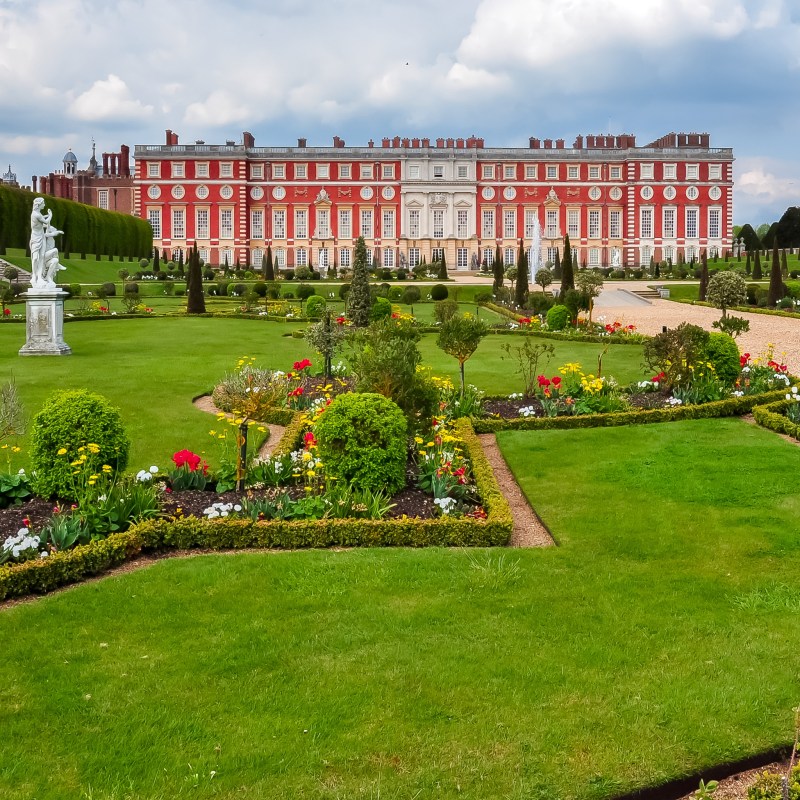
Hampton Court Palace in London is grand, historic, and surrounded by beautiful gardens. Visitors can freely wander, exploring life in a royal palace from the Tudor, Stuart, and Georgian times.
Managed by Historic Royal Palaces, Hampton Court Palace can tell as many stories as you have time for.
My first visit was a family trip long ago, when our young daughter was studying the Tudors at school.
I had no idea it would be so wonderful. It was the first time I had visited a palace, and I was hooked. I joined Historic Royal Palaces, and I still visit whenever I can.
Here are a few reasons I love Hampton Court Palace.

1. It’s The Real Thing
Hampton Court Palace is an actual place where momentous things have happened. Many of them have to do with King Henry VIII, the best-known of the Tudors. For example, the Chapel Royal, which is open to visitors most days, played an important role in Henry’s life.
The pope wouldn’t permit an annulment of Henry’s marriage to Catherine of Aragon. After much argument, Henry decreed that England would no longer be a Catholic country. Generations of religious turmoil followed.
Hampton Court Palace was one of Henry’s many homes during these years. Imagine the many heated discussions he must have had right here.
Years later, Catherine Howard, Henry’s fifth wife, was sentenced to death for adultery. She pleaded unsuccessfully for mercy outside the Chapel Royal while the king prayed within. Catherine was executed by beheading.
In addition to all the real-life events that have happened here, plenty of movies have been filmed at Hampton Court Palace.

2. You’ll Learn More About The King Who Had Six Wives
Henry VIII did indeed have six wives over many years.
“Divorced, beheaded, died. Divorced, beheaded, survived,” is how children remember his wives.
Some people portray Henry as a jovial fellow, fond of the ladies. Others see him as a ruthless tyrant, obsessed with power and possessed of an overriding desire to preserve the Tudor family dynasty. You’ll be better able to judge after a visit to Hampton Court.
But Hampton Court isn’t only about the Tudors. The Stuarts and the Georgians are also part of the story, up to King George II.

3. You’ll See How The Palace Was Altered Over The Years
The palace is a giant building with formal rooms, modest apartments, grand halls, long corridors, and staircases ranging from servants’ speedways to venues for magnificent works of art. There are three major courtyards and several smaller ones. Surrounding the palace are some outbuildings, acres of gardens, and the River Thames.
The two main parts of the building are the Tudor palace of Henry VIII and the baroque palace of the joint rulers King William III and Queen Mary II, designed by Sir Christopher Wren.
From the ticket building, walk to the moat and through the impressive west gate into Base Court. This is the Tudor palace of the 1500s, all red brick and diamond shapes. The many ornate chimneys remind me of fisherman knit sweaters.
Later, you’ll see Clock Court and Fountain Court. The building style changes; white Portland stone enhances the brick. This is the baroque palace, which altered and partly replaced the Tudor palace.

4. It Fed Hundreds Without Electricity
Hampton Court Palace was like a hotel with a thousand rooms. When the reigning monarch was there, so were all the lords, ladies, ambassadors, visiting dignitaries, and others, as well as the many servants and staff needed to keep things going.
The energy and reality of their work shows up brilliantly in the Tudor kitchens, a highlight of any visit. In this great hall, with its high ceiling and massive fireplace, you can see how the Tudor cooks created elaborate banquets for hundreds of people. Some days, the fire will be burning, and if you are really lucky, you might see and smell meat roasting on the spit.
The Historic Royal Palaces organization has carefully researched and recreated Tudor recipes and cooking methods. On a visit, you’ll get to see some of the cooking utensils and ingredients used in the 1500s.
I like to start any visit by following the Kitchen Tour on the free audio guide.

5. You’ll Hear Stories From Costumed Docents
The costumed interpreters at Hampton Court are extremely good. They stay in character and wear highly detailed outfits. They’re approachable and will answer questions about their life and times. I’ve had the opportunity to meet King Henry VIII himself more than once.
Often, there are interactive mini-performances at different times of the day, in different parts of the palace, based on things that happened here. These always get me into the spirit of the place.

6. There’s Plenty For Children
Hampton Court Palace is used to having children visit, both with school groups and in families. There’s a big playground called the Magic Garden, a famous maze to get lost in, and plenty of space outdoors for those with a lot of energy.
The palace also offers self-guided interpretive adventures called Family Trails. Sometimes there are royal robes available at the audio-guide station for visitors large and small to try on.
Although there are some precious do-not-touch items here, for the most part, it’s easy to move through the palace without having to worry about breaking something irreplaceable.
Historic Royal Palaces does a good job of making their shops an extension of the site, offering, among other things, speciality items and well-chosen, relevant books and gifts. The Henry Shop is the most child friendly.
For food, I find the Tiltyard Cafe the most comfortable spot for people of all ages.

7. It’s Simply Magnificent
Hampton Court Palace stopped serving as a royal residence in the 1700s, during the Georgian period. It still exudes luxury and wealth, however, even though the royal family is long gone.
My favorite Hampton Court treasures are the wood carvings by Grinling Gibbons. Created in the late 1600s and early 1700s, Gibbons’s work features lifelike, delicate garlands of fruit, flowers, and cherubs framing some of the doors and works of art in the baroque palace.
Another unique prize, the massive Abraham tapestries hanging in the Great Hall, were commissioned by King Henry VIII and woven in Brussels with threads of gold and silver.
The Tudor ceiling of the Chapel Royal has been repaired and restored over the years. It now looks much as it did in its heyday, a dazzling sky of golden stars. The organ here was commissioned by Queen Anne in the early 1700s and is still played.
The lovely ladies in the paintings along the Communication Gallery are the Windsor Beauties, and in the William III State Rooms, there’s another set, the Hampton Court Beauties.
For more fine art from the Royal Collection, visit the Cumberland Art Gallery.
The massive astronomical clock in Clock Court tells the time, the day, the month, the phases of the moon, the tides, and the sign of the zodiac. It’s simply magnificent. On this clock, the sun revolves around the Earth. That’s what people believed in 1540, when the clock was created.

8. It’s Full Of Fascinating Remnants Of The Past
Many people have left their mark on Hampton Court Palace — literally. You can spot the formally carved initials of different kings and queens above the gates, on the ceilings, and on a wall outside.
The heraldic King’s Beasts lining the moat bridge are copies of a set originally sculpted for King Henry VIII. They represent the Tudor and Seymour ancestral families.
Bored servants, soldiers, guests — no one really knows — scratched graffiti on some of the stone window ledges and door frames. It’s interesting to wonder who traced their hand here or their initials there. So much of the palace is about royalty and famous people that it’s nice to see a common touch as well.

9. The Restored Gardens Are Spectacular
Hampton Court’s gardens are worth a visit on their own, especially in the summer when the flowers are in bloom and the massive rose garden smells heavenly.
The Privy Garden of King William III is the authentic garden William would have had 300 years ago, had he lived. I admire all the research, archaeology, horticulture, and hard work that brought this lost garden back to life so vividly in the 1990s.
What To Know Before You Go
Hampton Court Palace is a flat site. The buildings have stairs. Elevators may be available upon request. Please check the website for the most current accessibility information.
There’s a train from Waterloo Station to Hampton Court Station. From elsewhere in London, you’ll need to use the Transport for London Journey Planner. There’s no Tube station at Hampton Court, but there are buses and a parking lot.
You’ll need at least a half day to tour Hampton Court Palace, but you could easily spend a full day there. Spend the evening or even stay the night in one of the nearby riverside towns. I love Richmond upon Thames, about 30 minutes by bus from the palace. It’s on the Tube’s District Line.
For more to see and do in London, see this page.
